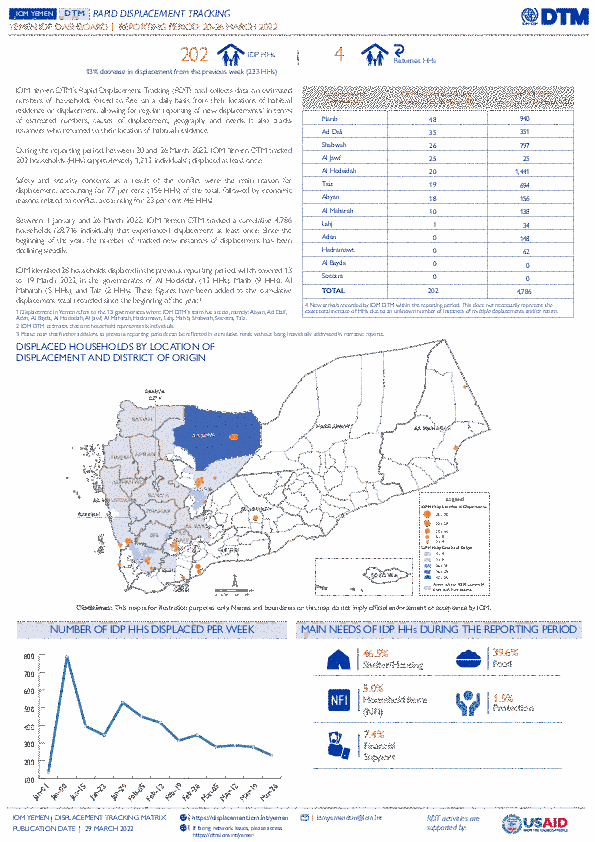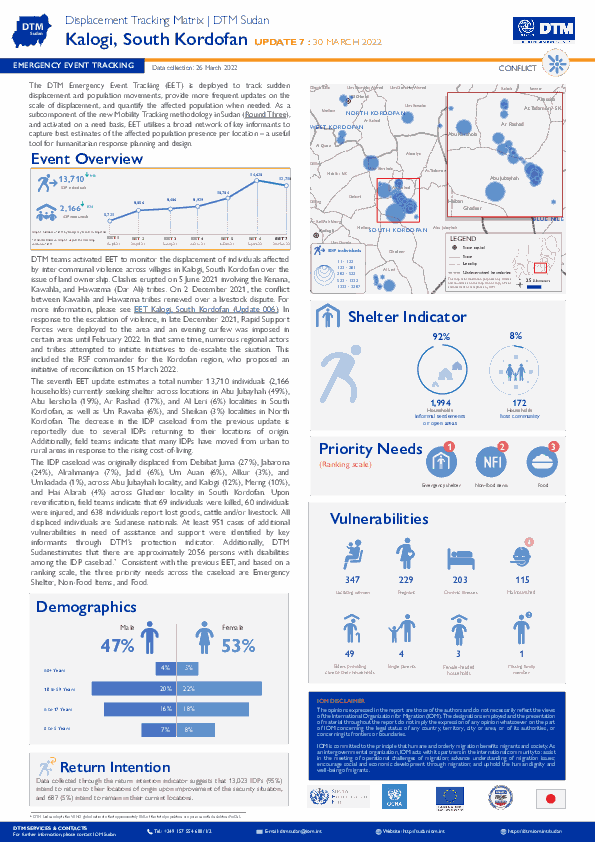-
Countries
-
Data and Analysis
-
Special Focus
-
Crisis Responses

Contact
DTM Europe, DTMMediterranean@iom.int
Language
English
Location
Belgium
Period Covered
Mar 22 2022
Mar 26 2022
Activity
- Survey
- Flow Monitoring
Between 22 and 26 March 2022, IOM conducted a rapid profiling survey of Third Country Nationals (TCN) displaced from Ukraine in Belgium. The study is intended to gather initial insights into the profiles of third country nationals displaced from Ukraine. IOM Belgium collected this information at the ‘Petit Chateau’ registration center in Brussels, with support from FEDASIL. In total 41 TCNs displaced from Ukraine agreed to voluntarily and anonymously complete the survey conducted by IOM staff. During the interview 71% indicated Brussels as their place of residence, 29% have registered in other cities.

Contact
DTM Nigeria, AllUsersInDTMNigeria@iom.int
Language
English
Location
Nigeria
Period Covered
Mar 19 2022
Mar 25 2022
Activity
- Mobility Tracking
- Baseline Assessment
- Points of Entry (PoE)
During the COVID-19 pandemic, IOM's Displacement Tracking Matrix (DTM), in collaboration with the World Health Organization (WHO), monitors cross-border movements to and from Nigeria's Borno State in north-east Nigeria. Assessments are conducted at Points of Entry located along the border with Cameroon.
A range of data was collected during the assessments to better inform on travellers’ nationalities, sex, reasons for moving, mode of transportation and timeline of movement as shown in figures 2 to 5 below.

Contact
DTM Nigeria, AllUsersInDTMNigeria@iom.int
Language
English
Location
Nigeria
Period Covered
Mar 20 2022
Mar 27 2022
Activity
- Event Tracking
- Mobility Tracking
Nigeria's north-central and north-west zones are afflicted with a multidimensional crisis rooted in long-standing tensions between ethnic and religious groups and involves attacks by criminal groups and banditry/hirabah (such as kidnapping and grand larceny along major highways). During the past years, the crisis has accelerated because of the intensification of attacks and has resulted in widespread displacement across the region.
Between the 20th and 27th of March 2022, armed clashes and banditry have led to new waves of population displacement. Following these events, rapid assessments were conducted by DTM (Displacement Tracking Matrix) field staff to inform the humanitarian community and government partners, and enable targeted response. Flash reports utilise direct observation and a broad network of key informants to gather representative data and collect information on the number, profile and immediate needs of affected populations.
During the assessment period, the DTM identified an estimated 3,761 individuals who were affected by the attacks. A total of 3,686 individuals were displaced to neighbouring wards in the LGAs Giwa and Kaura in Kaduna State and Gwer East in Benue State. A total of 104 casualties were reported, including 29 injuries and 75 fatalities.
Contact
DTM Yemen, iomyemendtm@iom.int
Location
Yemen
Activity
- Event Tracking
- Mobility Tracking
Period Covered
Mar 20 2022 -Mar 26 2022
Between 20 and 26 March 2022, IOM Yemen DTM tracked 202 households (1,212 individuals) displaced at least once. The majority of people moved into/within the following governorates and districts:
• Marib (48 HHs) – Marib City (33 HHs), Marib (14 HHs), Harib (1 HH) districts. Displacements in the governorate originated from Dhamar (10 HHs), Marib (8 HHs) itself and nine other governorates (30 HHs).
• Ad Dali (35 HHs) – Qatabah (17 HHs), Ad Dali (16 HHs), Al Hasayn (2 HHs) districts. Displacements in the governorate originated from Ad Dali (13HHs), Al Hodeidah (8 HHs) and four other governorates (14 HHs).
• Shabwah (26 HHs) – Ataq (26 HHs) district. Displacements in the governorate originated from Marib (9 HHs), Ibb (6 HHs) and six other governorates (11 HHs).
The majority of people moved from the following governorates and districts
• Taiz (37 HHs) – Maqbanah (9 HHs), Jabal Habashi (9 HH), At Taiziyah (5 HHs) and nine other districts (14 HHs).
• Al Hodeidah (36 HHs) – Hays (16 HHs), Jabal Ras (4 HHs), Al Jarrahi (4 HHs) and five other districts (12 HHs).
• Ibb (33 HHs) – An Nadirah (7 HHs), Hobeish (4 HHs), Al Qafr (4 HHs) and nine other districts (18 HHs).
Population Groups
Survey Methodology
Unit of Analysis Or Observation
Type of Survey or Assessment
Keywords
Geographical Scope
Administrative boundaries with available data
The current dataset covers the following administrative boundaries

Contact
DTM Yemen, iomyemendtm@iom.int
Language
English
Location
Yemen
Period Covered
Mar 20 2022
Mar 26 2022
Activity
- Rapid Emergency Registration
- Mobility Tracking
IOM Yemen DTM’s Rapid Displacement Tracking (RDT) tool collects data on estimated numbers of households forced to flee on a daily basis from their locations of origin or displacement, allowing for regular reporting of new displacements in terms of estimated numbers, geography, and needs. It also tracks returnees who returned to their location of origin.
From 1 January 2022 to 26 March 2022, IOM Yemen DTM tracked 4,786 households (HH) (28,716 Individuals) who experienced displacement at least once.
Between 20 and 26 March 2022, IOM Yemen DTM tracked 202 households (1,212 individuals) displaced at least once. The majority of people moved into/within the following governorates and districts:
- Marib (48 HHs) – Marib City (33 HHs), Marib (14 HHs), Harib (1 HH) districts. Displacements in the governorate originated from Dhamar (10 HHs), Marib (8 HHs) itself and nine other governorates (30 HHs).
- Ad Dali (35 HHs) – Qatabah (17 HHs), Ad Dali (16 HHs), Al Hasayn (2 HHs) districts. Displacements in the governorate originated from Ad Dali (13HHs), Al Hodeidah (8 HHs) and four other governorates (14 HHs).
- Shabwah (26 HHs) – Ataq (26 HHs) district. Displacements in the governorate originated from Marib (9 HHs), Ibb (6 HHs) and six other governorates (11 HHs).
The majority of people moved from the following governorates and districts
- Taiz (37 HHs) – Maqbanah (9 HHs), Jabal Habashi (9 HH), At Taiziyah (5 HHs) and nine other districts (14 HHs).
- Al Hodeidah (36 HHs) – Hays (16 HHs), Jabal Ras (4 HHs), Al Jarrahi (4 HHs) and five other districts (12 HHs).
- Ibb (33 HHs) – An Nadirah (7 HHs), Hobeish (4 HHs), Al Qafr (4 HHs) and nine other districts (18 HHs).
IOM identified 28 households displaced in the previous reporting period, which covered 13 to 19 March 2022, in the governorates of Al Hodeidah (12 HHs), Marib (9 HHs), Al Maharah (5 HHs), and Taiz (2 HHs). These figures have been added to the cumulative displacement total recorded since the beginning of the year.[1]
Methods used:
· DTM’s Rapid Displacement Tracking (RDT) tool collects and reports on numbers of households forced to flee on a daily basis, allowing for regular reporting of new displacements in terms of numbers, geography and needs.
Limitations:
· DTM Yemen is unable to report on figures in some governorates due to access limitations.
Let us know if you need any further information regarding displacement in Yemen.
[1] Please note that further additions to previous reporting periods can be reflected in cumulative totals without being individually addressed in narrative reports.

Contact
DTM Sudan; dtmsudan@iom.int
Language
English
Location
Sudan
Snapshot Date
Mar 26 2022
Activity
- Event Tracking
- Mobility Tracking
The DTM Emergency Event Tracking (EET) is deployed to track sudden displacement and population movements, provide more frequent updates on the scale of displacement, and quantify the affected population when needed. As a subcomponent of the new Mobility Tracking methodology in Sudan (Round Three), and activated on a needs basis, EET utilises a broad network of key informants to capture best estimates of the affected population presence per location – a useful tool for humanitarian response planning and design.

Contact
IOM Guyana, IOMGuyana@iom.int
Language
English
Location
Guyana
Period Covered
Sep 01 2021
Dec 14 2021
Activity
- Survey
- Flow Monitoring
For this exercise of data collection on Venezuelan migrants in Guyana, Snowballing was the elected method of obtaining a
sample size, interviews were done in person by going house to house, visiting shelters, businesses where migrants work, locations where migrants frequent and small migrant communities. Regions one, two, three, four, seven and nine were visited by IOM-led enumerator teams, demographics of migrants interviewed were Venezuelans, Guyanese returnees and Indigenous Venezuelans. From September 1st to December 14th, 2021, a total of 1,363 respondents participated in the data collection activity.
La crise dans le Bassin du lac Tchad est le résultat d’une combinaison complexe d’une multitude de facteurs, y compris un conflit armé impliquant des groups armés non étatiques, des niveaux extrêmes de pauvreté, un sous-développement persistent, et des bouleversements climatiques, qui ont conduit à des déplacements de populations importants. Au 28 mars 2022, le Cameroun, le Tchad, le Nigeria et le Niger accueillaient 5 496 858 individus affectés par la crise, dont des Personnes déplacées internes (PDI), des réfugiés et des retournés (anciennes PDI et retournés de l’étranger). 75 pour cent d’entre eux (soit 4 132 210 personnes) se trouvaient au Nigéria, 11 pour cent au Cameroun (628 918 personnes), 9 pour cent au Tchad (488 798 personnes) et 4 pour cent au Niger (246 932 personnes).
The crisis currently affecting the Lake Chad Basin states results from a complex combination of factors, including conflict with Non-State Armed Groups, extreme poverty, underdevelopment and a changing climate, which together have triggered significant displacement of populations. As of 28 March 2022, Cameroon, Chad, Niger and Nigeria were hosting an estimated 5,496,858 affected individuals made up of Internally Displaced Persons (IDPs), Refugees (both in- and out-of-camp), Returnees (Former IDPs and Returnees from abroad) and Third Country Nationals (TCNs). 75 per cent of the affected population (representing 4,132,210 individuals) were located in Nigeria, while 11 per cent resided in Cameroon (628,918 individuals), 9 per cent in Chad (488,798 individuals) and 4 per cent in Niger (246,932 individuals).

